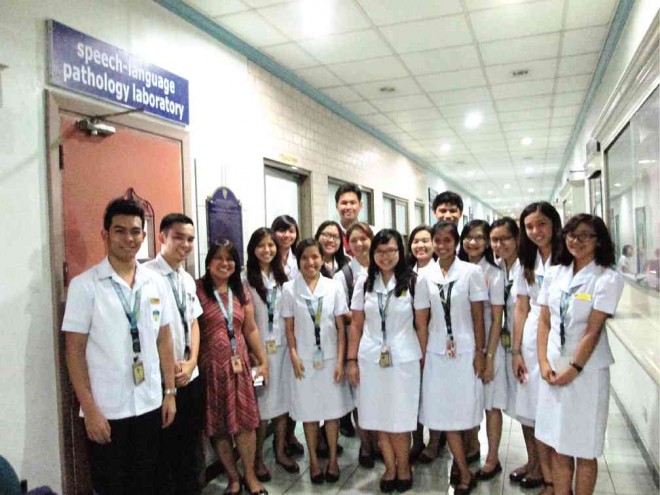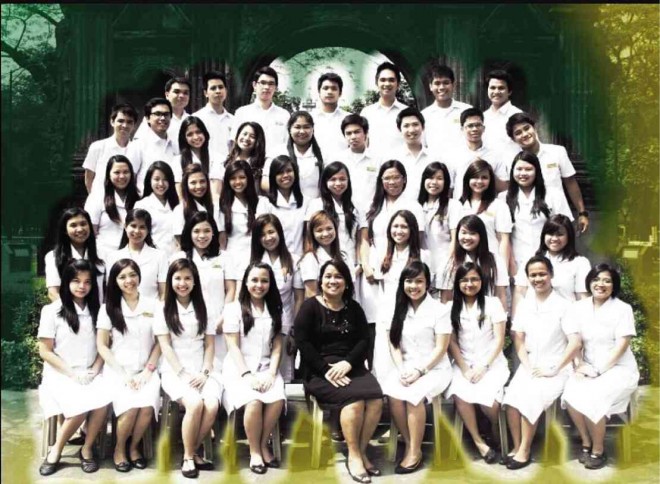At UST, it is BS SLP

FOURTH-YEAR speech language pathology students with Mojica (third from left)
credit: Princess Daisy C. Ominga
For the longest time, only the University of the Philippines offered a Bachelor of Science in Speech Pathology degree as an undergraduate course in the country.
In 2006, Dr. Norberto Martinez of the University of Santo Tomas Faculty of Medicine and dean Consuelo Suarez of the UST College of Rehabilitation Sciences (CRS) began talking about offering the course at the university as well. It was a natural addition to the rehabilitation courses at UST. The university was already offering BS Physical Therapy and BS Occupational Therapy degrees.
In 2009, under new CRS dean Jocelyn Agcaoili, UST added BS Speech Language Pathology (SLP) among the courses offered by the College of Rehabilitation Sciences (speech pathology is the general term used for the discipline).
What exactly is speech language pathology?
“Speech language pathology is an allied medical field … concerned [with] the communication disorders of individuals. It is the study of anything and everything about communications. We diagnose and provide intervention for patients who have lost the ability to communicate because of health problems, and kids who have development problems. We work closely with other allied health professionals like physical therapists, occupational therapists, rehab medical specialists, pediatricians, EENT, etc.,” explains professor Georgina Mojica, UST SLP department chair.
Young and old clients
Speech pathologists help stroke victims who have difficulty communicating (aphasics), people who suffer from dysphagia, or those who cannot talk well because of problems in swallowing, as well as kids who have anatomical problems such as cleft lip and palate, and hearing loss.
They also deal with kids with development problems, like autism, Down Syndrome and cerebral palsy. Children from regular schools with delayed speech and voice problems are also among their clients.
It took 31 long years before another school followed UP’s lead. Mojica says there was a need to establish and stabilize the speech pathology field first. It was also difficult to organize a faculty as there were not enough practitioners.
Mojica, one of the first UP speech pathology graduates, says Martinez asked her to start a speech language pathology program at UST in 2009.
“Since I will be holding an administrative position, I had to give up my private practice to devote my time to the academe. But the other faculty members still practice,” she says.
From the beginning, the number of enrollees has been overwhelming. The school gets up to 400 applications, but UST accepts only up to 45 students due to limited resources. Selection of the 45 applicants is a very meticulous process.
“There has been a steady demand for speech pathologists. Because of this, we have to choose not only the best among the applicants. We also look into their future plans. If we get an applicant who plans to go back and practice in the province after graduation, we take that into consideration,” says Mojica.
Aside from communication skills, high grades in science and English are required to get into the program, according to the professor.

MOJICA demonstrates, with fifth-year intern Chia Floro, the
nasometer, a device used in therapy for cleft palate patients.
PRINCESS DAISY C. OMINGA
Five-year course
A four-year course at UP, the Commission on Higher Education issued Memorandum Order No. 29 in 2011 directing other higher education institutions to make it a five-year course. The extension is expected to give students ample time and experience to prepare for the task ahead.
“Four years is too cramped. Internship takes one year. When I developed the curriculum for SLP in UST, I thought that if we stretch it to five years like PT (Physical Therapy) and OT (Occupational Therapy), it (the course) would not only be more student-friendly but, professionally, make them better prepared,” explains Mojica.
Under the UST SLP program, the first two years cover general education, the next two, Speech Language Pathology professional courses and the final year, internship.
Students are trained to deal with different kinds of patients, from adults who suffer from an abrupt loss of communication skills, to kids who cannot express themselves verbally.
As early as their second year, students are given courses in Normal Human Development, which include initial training in dealing with patients. Only fifth year students, however, can deal with patients personally, as part of their internship.
The others can only watch through video projectors in the SLP laboratory actual consultations and therapies.
“Right now, we have 41 fifth-year interns scattered among 19 affiliate centers. Some are in PGH (Philippine General Hospital), UST Hospital, National Kidney Institute, Victor Potenciano Hospital and Veterans Hospital, while others are in therapy centers. We also have a community-based program in Bataan. Students are required to intern for two months in each center,” says Mojica.
Those in the lower years get exposure through activities, like the SLP Day, a school fair where special children interact with students for a firsthand experience of situations they will deal with in the future.
In the second year, students are given an orientation to help them decide if they will remain in the program. Shifting to another course is difficult after third year as some SLP subjects will not be credited in other programs.
“This process helps weed out those who are not really serious in pursuing a career in speech pathology,” explains Mojica.
A quick profile of most UST SLP students, Mojica says, shows that majority of them are women and only about 10-20 percent are men.
They are, Mojica says in jest, maingay (noisy). But this mostly stems from their being people persons and socially oriented. They are also very patient and thorough in their work.
As the course is very demanding, she says students should be intellectually adept in handling different situations when dealing with patients.
The SLP faculty encourages students to help raise awareness and prevention.
“We tell them not just to be clinicians, but also to be advocates, to go to the communities and do programs to increase awareness. Advocacies can also be practiced in class, like telling other students to use earphones in moderation because prolonged use can lead to hearing loss,” Mojica says.
In March, UST graduated its first speech language pathology class. Of the 38 graduates, 35 are practicing in the country, 12 of them in the provinces. Two went on to study medicine, while one went to the United States.
The top graduate, a Rector’s Award recipient, joined the UST faculty after graduation, becoming the first and so far the only Thomasian on the SLP faculty.
The original faculty members are all UP graduates. Except for two professors who hold administrative positions, they all have private practices.
With only UP offering a Master’s Degree in Speech Pathology in the country, graduates can take graduate courses in related fields.
So far there is no SLP board examination. The Philippine Association of Speech Pathologists has asked Congress to pass a law to regulate speech pathology practice in the country through a licensure test.
